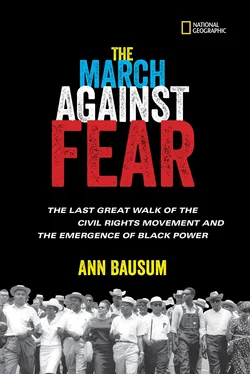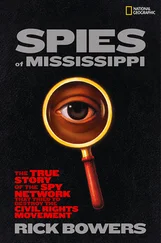An older woman watched through her screen door as marchers passed her rural Mississippi home. Undated photo. Credit 12
When the federal government tried to intervene on behalf of blacks, local whites resisted. After the U.S. Supreme Court ordered the integration of public schools in 1954, Mississippi legislators considered abolishing their public schools. In the end, they continued the state’s education system but provided publicly funded vouchers to help white families send their children to segregated private schools. When the federal government offered vital food supplies and provided free services such as health care and preschool education to Mississippi’s poor, many whites criticized the programs as an alarming imposition of federal will on one of its 50 states. Such criticism was hypocritical because many whites benefited from federal aid, too. But, whites tended to view their own government support, such as a generous crop subsidy program for cotton farmers, as valid even as they dismissed federal handouts for poor people, who were so often black.
The few whites who expressed their disagreement with segregationists risked condemnation, loss of business support, and more. Even when only a minority of whites in a community joined supremacist organizations such as the Ku Klux Klan and local White Citizens’ Councils, their voices and actions came, by default, to represent the white majority.
As a result, it took outsiders and mass action to break down a system nurtured by centuries of slavery and 100 years of post–Civil War segregation. Mississippi had become so segregated that whites might not even realize the depths of its racial oppression. They saw blacks on their terms—as maids, as field hands, as customers. Whites were far more likely to attribute the lag in the advancement of such folks to some inherent lack of ability or to an innate dislike of hard work rather than acknowledge the yoke of impoverishment and hopelessness that was the legacy of slavery.
Civil rights leaders wanted to peel back the veneer that made segregation seem okay. They’d made progress in Alabama. They’d made progress in other states in the South. But civil rights leaders had found Mississippi to be tough territory in the past, and no one could be sure that this time would be different.
Still, they marched.
On Friday, June 10, the fourth day of the revived march, 155 people set off on a 15-mile route, heading toward Sardis and points beyond. Locals welcomed the marchers to their town with a homemade picnic lunch; then some 100 residents from the area joined hikers for the day’s remaining 10 miles. Even more people joined the procession as it neared its stopping point in Batesville, allowing the day’s march to conclude with a crowd of more than 500 participants. Local blacks once again fed the marchers, offering up a feast that included barbecue, fried chicken, fresh vegetables, corn bread, and desserts.
Perhaps best of all, the first tent had arrived. Three more would follow in the coming days. For the first time, hikers had the option to sleep along the route. No more commuting. Volunteers erected the rented circus tent on the grounds of a local church, and some 300 people bedded down for the night, intent on resuming their hike the next morning.
By sleeping on-site, the marchers were able to make an earlier departure than on previous days. On Saturday morning, June 11, hundreds of them paraded into Batesville bound for their first stop at a county courthouse. The courthouses of Mississippi served as the hubs for voter registration in the state, and the Panola County courthouse offered organizers a prime spot to test their influence on voter registration. Some marchers literally danced into town, singing freedom songs, clapping, and swaying in time to an irresistible beat. Courage, freedom, justice , the rhythm seemed to say. Have courage. Seek freedom. Find justice
Конец ознакомительного фрагмента.
Текст предоставлен ООО «ЛитРес».
Прочитайте эту книгу целиком, купив полную легальную версию на ЛитРес.
Безопасно оплатить книгу можно банковской картой Visa, MasterCard, Maestro, со счета мобильного телефона, с платежного терминала, в салоне МТС или Связной, через PayPal, WebMoney, Яндекс.Деньги, QIWI Кошелек, бонусными картами или другим удобным Вам способом.












